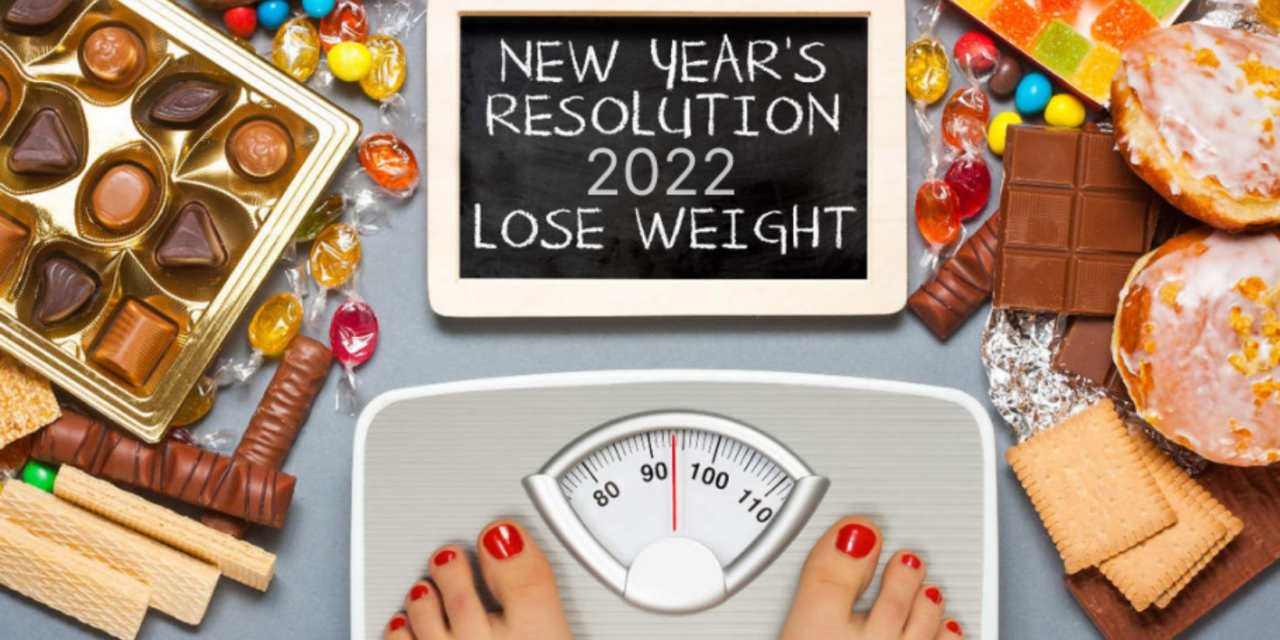
Successful Weight Loss Strategies for the New Year!
By: Dr. David Friedman
It’s January 2022 and time to focus on that New Year’s resolution of improving your health and losing weight! Unfortunately, 95% will give up on their New Year’s resolution by March 1st. Why do so many of us experience failure when trying to achieve our optimal weight? The word diet is derived from the Greek word diatia, which means “way of living.” Sadly, most people think the definition of diet means counting calories, drinking meal-replacement shakes, and taking a handful of the latest weight-loss pills. Doing these things will only bring temporary results because they do not address the real meaning of the word diet.
On my radio show, I’ve been asked many times to weigh in and throw down the gauntlet on which diet works and what philosophy is most sound. I can honestly tell you, “They ALL work!” Whether it’s eating for your blood type, Atkins, Paleo, Keto, South Beach, Vegan, Nutrisystem, Weight Watchers, or any variation that exists now or in the future, if you stick to the program, you will experience weight loss… initially.
One of the main reasons why so many different diets work is because they all have one thing in common—they change a person’s routine. They all promote eating different foods in different ways at different times. Whether it’s eating just grapefruits or steak every day, counting calories, changing your portion sizes, or going vegan; when you mix up your daily routine, you will alter your metabolism, change your blood glucose levels and pH, which in turn, can lead to a weight loss. Unfortunately, most of the time, the results are just temporary.
If you’ve tried one of the many weight-loss plans or followed a fad diet, you know this to be true. The majority of you lost the most weight in the first thirty days, continued to lose weight in month two, and only lost a minimal amount of weight after day ninety. By the fourth month, you reached a plateau and became frustrated, which made you walk away from the diet you were on that “was” working. What are you supposed to do then? Continue buying tickets to ride a merry-go-round of fad diets and make the same New Year’s resolution next year and the year after that?
Changing your routine leads to initial weight loss but changing your lifestyle will bring permanent weight loss. In my book, Food Sanity, how to eat in a world of fads and fiction, I set the record straight and share how you can finally lose weight and keep it off! I reveal the obstacles of permanent weight loss, and (brace yourself)… more exercise is not the answer!
If losing weight is your New Year’s resolution (once again,) but this time you would like to follow through and keep the pounds off, here are the guidelines to help you say goodbye to those unwanted pounds!
If losing weight is your New Year’s resolution (once again,) but this time you would like to follow through and keep the pounds off, here are the guidelines to help you say goodbye to those unwanted pounds!
Get More Sleep!
The amount of time Americans spend sleeping has steadily declined while the average body mass index (BMI) of Americans increased reflecting a trend toward elevated weight gain and obesity. Research shows that not getting 7 hours of deep restorative sleep each night can lead to metabolic disorders, weight gain, and an increased risk of obesity and other chronic health conditions. Another study shows getting less than 6 hours of sleep a night is linked to an increased risk of early death! According to a report from Gallup, 40 percent of Americans are sleeping 6 hours or less each night.
A lack of deep restorative sleep puts the body’s hormones off balance, which highly impacts hunger and fat accumulation. A big culprit of belly fat is the hormone cortisol, which increases when we are sleep-deprived. Also, our appetite-regulating hormones ghrelin and leptin are affected. When we don’t get enough sleep, our ghrelin levels (the hormone that makes us feel hungry) rise, and our leptin levels (the hormone that makes us feel full) drop. This means when we’re awake, we tend to eat more but feel less satisfied.
For my tips on how to sleep those unwanted pounds away click here.
Avoid Obesogens: The Environmental Link to Obesity
Exercise Makes Losing Weight Difficult!
More people join a gym in January than all the other eleven months combined! The truth is exercise is important and necessary for a healthy body, but if you want to lose weight, changing your diet is far more effective. It takes 750 jumping jacks to burn off 150 calories. However, eliminating one soda subtracts 150 calories. Which has a greater impact? Considering the average person consumes three to five sodas every day, it seems pretty obvious that you can’t spend every day doing four thousand jumping jacks to erase your lousy dietary choices.
Have you noticed, the more you exercise, the hungrier you get? That’s because exercise actually stimulates hunger! This causes you to crave more food and eat more, which in turn, negates the weight-loss benefits of exercise. The truth is exercise makes losing weight more difficult! The peer-reviewed journal PLoS ONE, published a study comparing overweight women that don’t exercise regularly to those that do. Women were placed into four groups. Three of the groups were asked to work out with a personal trainer, for six months. Women in the fourth group were the controls—they maintained their normal daily activity routines and did not exercise. None of the women in any of the groups changed their dietary habits. Those who exercised with a trainer several days a week for six months maintained more weight than the control subjects. In fact, the study found that the women who exercised ended up eating more calories than they did before they started the experiment. Those who exercised intensively with a trainer lost less weight.[16]
The Journal of Obesity Research published a study conducted by a Columbia University team, which showed a pound of muscle burns approximately six calories a day in a resting body, compared to two calories that a pound of fat burns.[17] This means, if you worked out enough to burn off 10 pounds of fat, you would be able to eat only an extra forty calories per day, about the amount in a teaspoon of butter, before beginning to gain the weight back. So, if after a vigorous workout you drank a 20-ounce bottle of Gatorade (130 calories), your hard workout would be futile because the caloric expenditure from the workout and your caloric intake becomes a wash. As you can see, because your body is starving after a workout, a vicious cycle ensues. That old wives’ tale “you lose weight by burning more calories than you eat” is wrong. No matter how many jumping jacks you do or how long you ride that stationary bike, you can’t unrun your fork! People lose weight in the kitchen and get toned in the gym. If your goal is to lose weight, focus on your diet, not exercise.
Don’t Count Calories!
Fad diets come and go, but the most popular diet of the last century is calorie counting. It’s become the standard methodology for people wanting to lose weight. But even as far back as 1924, prominent medical doctor Dr. Phillip Norman questioned the value of calorie counting, “The conception of the calorie has retarded logical and rational reasoning in regard to diet, more so than any single other factor.”[18] The problem with a calorie-counting diet is that it can put your body into a “famine” mode that causes you to gain back your original weight and sometimes even more. This is why calorie-counting diets are often referred to as “yo-yo diets.” By definition, a calorie is a measurement of heat. It’s the amount of heat required to raise the temperature of one kilogram of water through one degree Celsius. A calorie is heat! If heat caused weight gain, everyone living in the southern hemisphere would be obese. But actually, they’re leaner.[19]
The biggest calorie-counting organization in the world is called Weight Watchers. They’ve been having people count calories for more than fifty years! Interestingly in 2011 David Kirshaw, CEO of Weight Watchers, said in a Time magazine interview, “Calorie counting has become unhelpful. When we have a 100-calorie apple in one hand and a 100-calorie pack of cookies in the other, to view them as being ‘the same’ makes no sense.”[20] For Weight Watchers to make a statement like that really puts into perspective the lack of success calorie counting has when it comes to losing weight and keeping it off. Calorie counting diets simply do not work! It also means having to become a mathematician and that takes the enjoyment out of eating. Instead of counting calories, make your calories count! Eat wholesome foods from nature and put away your calculator.
While so many fad diets have come and gone, for three decades I’ve recommended the same eating plan for my patients. It has helped thousands balance their blood sugar, increase their energy levels, and lose unwanted pounds. You too can achieve this by simply living by the mantra, “If it’s white, keep it out of sight!” When I say white, I’m referring to foods that are white in color and have been processed and refined like milk, flour, rice, pasta, bread, crackers, cereal, and anything sweetened with table sugar or high-fructose corn syrup. There are a few natural exceptions to this rule: cauliflower, garlic, mushrooms, onions, potatoes, bananas, white fish, and white poultry meat.
The other white foods contain a high concentration of simple carbohydrates that will make your blood sugar spike and then drop, causing you to overeat and gain weight. Public enemy #1 on the “no white” list is sugar! The average person consumes 160 pounds of refined sugar every year! That is a lot of sugar—especially when you compare it to how much we consumed in the past. Eighty years ago, the average intake of sugar was only about 4 pounds per person per year. That’s a 4,000 percent increase in sugar consumption today!
Sugar is a major cause of our obesity epidemic. If you are not one to add table sugar to your food or beverages, you are probably still consuming too much sugar. This sweetener can be hidden in foods like canned or jarred tomato sauce (15 grams of sugar per half-cup serving), granola bars (12 grams of sugar), Greek yogurt (17 to 33 grams of sugar per 8-ounce serving), and Vitamin Water (one 20-ounce bottle has about 32 grams of added sugar)!
Also, stay clear of processed grains like pasta because even though you won’t see a lot of “sugar” listed on the label, it increases your blood sugar and triggers a release of insulin. By eating more whole grains like brown rice, oats, barley, rye, and quinoa, you are getting a great source of fiber, which creates a slower absorption rate and keeps you feeling full longer. For people suffering from celiac disease or gluten sensitivity, the best choice is buckwheat.
If you want to sweeten your coffee, tea, or if a recipe requires sugar, you can use pure raw honey, organic coconut sugar, organic maple syrup, yacón syrup, stevia, or monk fruit.
Avoid Obesogens: The Environmental Link to Obesity
Many people have a hard time losing weight and keeping it off no matter what diet they try or how much they exercise. If that’s something you can relate to, it could be because you’re being exposed to obesogens. These are chemicals, either natural or man-made, that take control of your metabolic systems, causing weight gain. They come from compounds found in certain plastics; in pesticides and fungicides; in soy and sweeteners; and in the hormones that are injected into our livestock. These obesogens increase appetite and disrupt normal development and lipid metabolism, all of which can lead to obesity. They create a hormonal imbalance including our growth hormone, insulin, and cortisol. People exposed to obesogens may also suffer from a deficiency or change in the ratio between androgen and estrogen sex steroid levels, which normally modifies the fat balance in the body. This can lead to lowered growth hormone secretion, unbalanced cortisol levels, and increased resistance to insulin.[1] Obesogens can be found in makeup, water bottles, nonstick pans, microwave popcorn, and even your shower curtain. In fact, the average person is exposed to over 100 obesogens every day! Additionally, obesogens have been correlated with heart disease, diabetes, obesity, and high cholesterol.[2]
The Most Common Obesogens
High-fructose corn syrup (HFCS) is a leading cause of obesity, especially in children. This is the most common food and drink sweetener on the market. This obesogen wreaks havoc on the insulin and appetite-regulating hormones; fooling you into thinking you’re hungry, even if you are not. This increase in appetite leads to fat production.[3] HFCS is cheaper than sugar, thanks to the government’s farm bill corn subsidies. Products with HFCS are sweeter and cheaper than products made with cane sugar. This allows the average soda size to go from 8 ounces to 20 ounces with no additional costs to the manufacturers. In June 2004, The Journal of Clinical Endocrinology & Metabolism showed that ghrelin, the hormone that makes you feel hungry and tells you to eat, was not suppressed after eating HFCS.[4] In May 2009, the Journal of Clinical Investigation showed that participants assigned to a high-fructose drink gained more visceral fat compared to the group with a high-glucose drink. In other words, a high fructose intake is more likely to create abdominal fat than sugar. Abdominal fat is considered the most dangerous fat because it’s associated with an increased risk of type 2 diabetes and cardiovascular diseases.[5]
Bisphenol-A (BPA), a synthetic estrogen primarily used to harden plastics, has been shown to increase insulin resistance. BPA is found in plastic food and beverage containers, canned foods, baby formulas, bottle tops, and water supply lines. Some dental sealants and composites also contain BPA. The United States produces 6 billion pounds of BPA annually, and it’s detectable in 93 percent of Americans. This chemical is also found in thermal paper items including receipts, event and cinema tickets, labels, ATM receipts, and airline tickets.[6] If you put one of these receipts in your wallet and it makes contact with money, this causes a dramatic increase in the concentration of BPA on your currency; making the paper money you handle a secondary source of exposure. [8] That means you are getting a dosage of the female hormone estrogen from your money. In addition to the BPA being linked to health problems such as various cancers and infertility, it has also been shown to be a major contributor to the obesity epidemic. [9] A pregnant woman should never touch their eyes, nose, or mouth after handling these thermal-paper products!
You can avoid BPA on plastic containers by following the numbers. If you see the number 7 or 3 in the recycle emblem don’t purchase the product, it contains BPA. The saying I coined to make this easy to remember is, “Seven or three, not for me!”
Pesticides used to destroy pests that feed on fruits and vegetables are linked to obesity, diabetes, and other morbidities.[10] The average American is exposed to ten to thirteen pesticides every day, and 90 percent are endocrine disrupters, which have been linked to obesity. You can avoid consuming pesticides by purchasing produce that is “USDA Certified Organic.” Or look for the number “9” on the PLU (Price Look-Up) label. That ensures it’s organic and doesn’t contain pesticides. The saying I coined is, “Nine is Fine!”
Perfluorooctanoic acid (PFOA) is a surfactant used in nonstick cookware. PFOA has been detected in the blood of more than 98 percent of the general U.S. population.[13] It is a potential endocrine disruptor linked to obesity.[14] Avoid all pots and pans that are coated with a nonstick material.
Hormones such as estrogen, progesterone, and testosterone are being used to increase the weight of cattle. When you eat cattle, these same substances can increase the weight in YOU! A study in the International Journal of Obesity from researchers at ten different universities, including Yale University School of Medicine and Johns Hopkins University, found that the use of steroid hormones in meat production and on conventional dairy farms could be contributing to obesity. [15]
Antibiotics in chicken and farmed fish. Because chicken and farmed fish are kept in small pens/cages, antibiotics are often used to help them fight off infection and grow larger. These antibiotics are obesogens. Look for “USDA Certified Organic,” “Wild Caught,” “Grass-Fed” and “Pasture Raised” on the label.
For more tips on how to avoid these chemicals, listen to my podcast: Hidden Chemicals Sabotaging Your Weight Loss Goals
Make 2022 the year you finally achieve your optimal weight.
REFERENCES:
[1] Björntorp, P. 1997. “Body Fat Distribution, Insulin Resistance, and Metabolic Diseases.” Nutrition 13 (9): 795–803.
[2] “Chemicals in Food Can Make You Fat.” CBS News. February 11, 2010 http://www.cbsnews.com/news/chemicals-in-food-can-make-you-fat/.
[3] Stanhope, K. L. 2012. “Role of Fructose-Containing Sugars in the Epidemics of Obesity and Metabolic Syndrome.” Annu. Rev. Med. 63: 329–43.
[4] Teff, Karen L., et al. 2004. “Dietary Fructose Reduces Circulating Insulin and Leptin, Attenuates Postprandial Suppression of Ghrelin, and Increases Triglycerides in Women.” The Journal of Clinical Endocrinology & Metabolism June. 89 (6): 2963-2972.
[5] Stanhope, Kimber L., et al. 2009. “Consuming Fructose-Sweetened, Not Glucose-Sweetened, Beverages Increases Visceral Adiposity and Lipids and Decreases Insulin Sensitivity in Overweight/Obese Humans.” J Clin Invest 119 (5): 1322–34. doi: 10.1172/JCI37385. Epub 2009 Apr 20.
[6] Raloff, Janet. 2009. “Concerned about BPA: Check Your Receipts.” Science News, October 7. Accessed May 10, 2016.
[7] Tavernise, Sabrina. 2012. “F.D.A. Makes It Official: BPA Can’t Be Used in Baby Bottles and Cups.” The New York Times, July 17.
[8] Liao, C., and K. Kannan. 2011. “High Levels of Bisphenol A in Paper Currencies From Several Countries, and Implications for Dermal Exposure.” Environ. Sci. Technol. 45 (16): 6761–8.
[9] Vom Saal, F. S., and S. C. Nagel, et al. 2012. “The Estrogenic Endocrine Disrupting Chemical Bisphenol A (BPA) and Obesity.” Mol. Cell. Endocrinol 354 (1-2): 74–84.
[10] Thayer, K. A., and J. J. Heindel, et al. 2012. “Role of Environmental Chemicals in Diabetes and Obesity: A National Toxicology Program Workshop Report.” Environ Health Perspect 120 (6): 779–89.
[11] National Heart, Lung, and Blood Institute, United States National Institutes of Health. 1998. “Clinical Guidelines on the Identification, Evaluation, and Treatment of Overweight and Obesity in Adults—The Evidence Report. National Institutes of Health”Obes. Res. 6 (Suppl 2): 51S–209S.
[12] Blumberg, Bruce. 2012. “Chemicals That Make You Fat.” Living On Earth: PRI’s Environmental News Magazine, June 1. Accessed May 11, 2016. http://www.loe.org/shows/shows.html?programID=12-P13-00022#feature2
[13] Shankar, A., and J.Xiao J, et al. 2011. “Perfluoroalkyl Chemicals and Elevated Serum Uric Acid in U.S. Adults.” Clin Epidemiol 3: 251–8.
[14] Holtcamp, Wendee. 2012. “An Environmental Link to Obesity.” Environ Health Perspect 120:a62–a68.
[15] Y Wang, et al. 2009. “Meat Consumption Is Associated with Obesity and Central Obesity Among U.S. Adults.” International Journal of Obesity (Lond). 33 (6): 621–28. http://www.nature.com/ijo/index.html.
[16] Church, T. S., and C. K. Martin, et al. 2009. “Changes in Weight, Waist Circumference and Compensatory Responses with Different Doses of Exercise among Sedentary, Overweight Postmenopausal Women.” PLoS ONE 4 (2): e4515. doi:10.1371/journal.pone.0004515
[17] Wang, Z., et al. 2001. “Resting Energy Expenditure: Systematic Organization and Critique of Prediction Methods.” Obesity Research 9 (5): 331–6.
[18]Shelton, Herbert M. 1999. “Hygienic System Vol. II – Orthotrophy.” Health Research Books, February, p. 229. .
[19] Innes, Emma. 2014. “People Who Live in the Northern Hemisphere Are Fatter ‘Because of the Cold Climate.” Dailymail, February.
[20] Sachs, Andrea. 2011. “Weight Watchers Dieters Can Have a Free Lunch?” Time magazine, Saturday, February 19 http://content.time.com/time/magazine/article/0,9171,2042344,00.html




